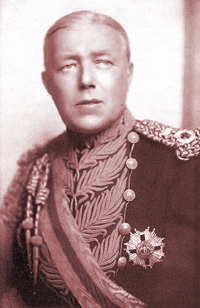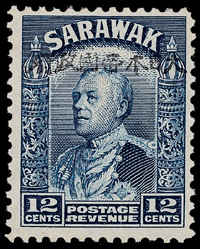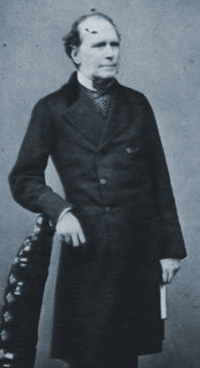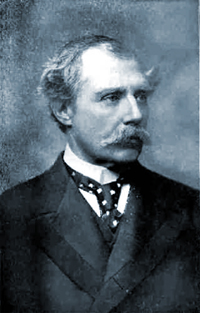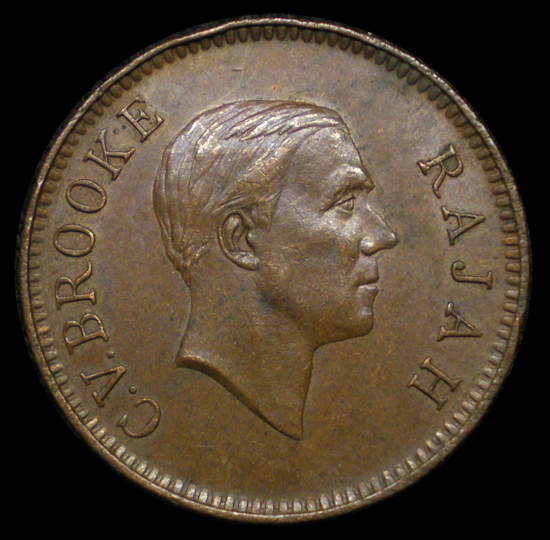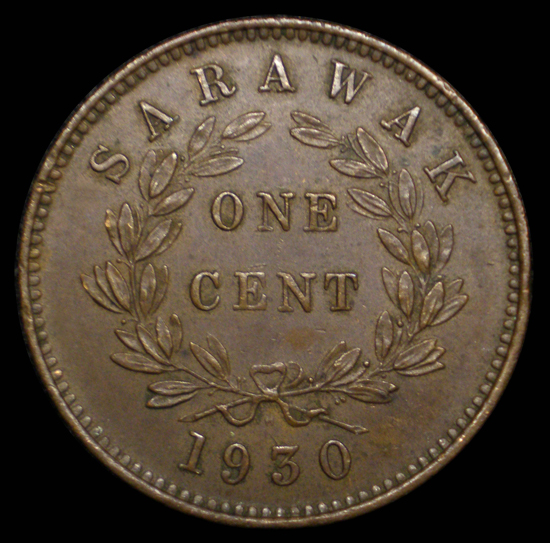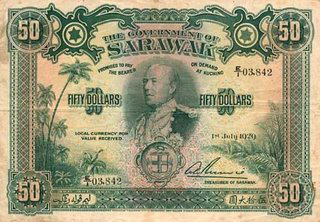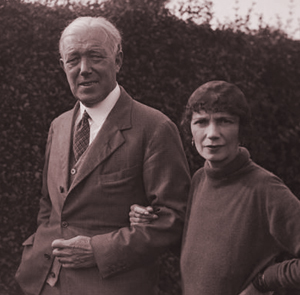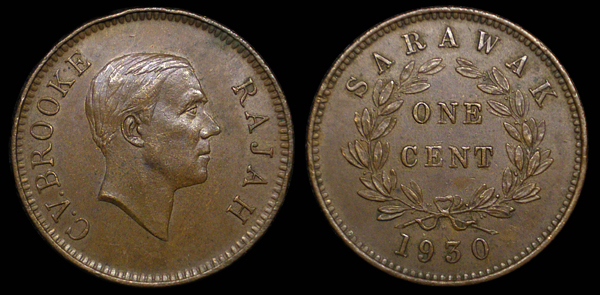
1 CENT COIN - SARAWAK - RAJAH VYNER
(KM 18)
Date: A.D. 1930
Obverse: Portrait facing right - C.V.BROOKE RAJAH
Reverse: Wreath - SARAWAK ONE CENT 1930
Ralph Heaton & Sons - Birmingham
James Brooke, the first white Rajah of Sarawak
Charles Anthoni Johnson Brooke: Second white Rajah of Sarawak and father of Charles Vyner Brooke |
This one cent coin was minted By Ralph Heaton & Sons of Birmingham in the thirteenth regnal year of Charles Vyner Brooke. He is the third and last 'White' Rajah of Sarawak, a state on the island of Borneo ruled for about 100 years by the Englishman James Brooke and his family. Borneo, located in South East Asia, is the third largest island in the world. It has been known for its abundant natural resources by China and India as far back as the 6th century AD and its coastal settlements served as lucrative trading ports. By the time the adventurer James Brooke arrived in Sarawak it was a part of the Sultanate of Brunei in decline. The Brunei Islamic Malay Sultanate saw its golden age from the 15th to 17th centuries and ruled a large part of the Northern Borneo coastal territories. By this time the power of the Sultanate was in decline and many territories were in revolt. Much of Inland Borneo was inhabited by numerous Dayak tribes. Daytak is a loose term for over 200 tribal ethnic subgroups principally in the interior of Borneo. Many Dayak tribes were opposed to rule by Brunei. James Brooke was the son of a British magistrate. He was born in the town of Bendel in the Hooghly District in British India and spent much of his childhood there before moving to England to attend school at around 12 years of age. As a young man he returned to India and served in the Bengal Army of the British East India Company. He saw action in Burma until he was seriously wounded in 1825. After his recovery in England he resigned to seek his fortune in trade with the far east. Failing at this his first time out, he sunk a sizable inheritance into the purchase of a 142-ton schooner dubbed the Royalist and set sail for the island of Borneo. He reached the port city of Kuching in 1838 where he found chaos, civil unrest, pirates and eventually good fortune. As the power of the Sultanate diminished, Sarawak, rich in the trade of antimony and many other goods, looked to make a bid for independence. The Sultan of Brunei, Omar Ali Saifuddin II, dispatched his uncle, Rajah Pangeran Muda Hashim, to pacify any rebellious activity. Hashim, overwhelmed by the task, sought aid from the Englishman James Brooke who was anchored at Kuching. Brooke was confident the British would support any action that would prevent greater Dutch influence on the island. After some delay, he accepted the task only after he was offered effective control of Sarawak as a reward. Through the use of superior firepower, James Brooke and his men managed to quell the rebellion and help bring about a relatively peaceful settlement. Brooke held the hesitant Pangeran Muda Hashim to his word and a treaty between Brooke and Hashim was signed in 1841. The treaty ceded to Brooke control over Sarawak, specifically Kuching and its surrounding territories. On September 24, 1841, Pangeran Muda Hashim bestowed the title of Rajah to James Brooke and he was officially confirmed by the Sultan on August 18, 1842. By a fortuitous twist of fate, this Englishman had become the first white Rajah. The absolute ruler of Sarawak. The title of Rajah meant a princely ruler of a state. In this case the Rajah was often acting in the capacity of a governor under the Sultan. Although the land and title was bestowed upon him by the Sultan of Brunei, Brooke ruled as an independent and absolute monarch. He spent much of his rule reforming the ineffective government, the legal system of the Sultanate, and securing the territory against pirates and usurpers. For his efforts he was also appointed governor and commander-in-chief of Labuan (an island ceded to the British by the Sultan of Brunei), British consul-general in Borneo and he was created a Knight Commander of the Order of the Bath. Both he and Britain benefited from a mutual understanding. Sarawak was more a strong ally with Britain and less a colony. He was known to rule with a mind towards local custom and tradition. He took the official stance of protector, limiting western influence and exploitation of his new Kingdom. How much this position also allowed him to enrich himself in the process is debatable. He and his successors would act against local custom only when they found it to be grossly improper. Around Sarawak were the Iban or the 'Sea Dayak', a comparatively large and powerful sea faring tribe among the Dayak. Many Dayak tribes practiced headhunting and the Iban were one of the more prolific practitioners of this as well as piracy. The eradication of Dayak headhunting and piracy would be a principal goal for James and those who came after him. His life seems like a story pulled from a fantasy adventure novel of the colonial era. A British adventurer looking for fortune is in the right place at the right time and becomes the absolute princely ruler of a nation in the east. Lacking an heir to his title, James Brooke named Captain John Brooke Johnson-Brooke, his sister's oldest son, as his successor. Although it is known that John was active in fighting pirates and governed the Kingdom while his uncle was away, he apparently angered his James and was banished from the kingdom to be replaced as heir apparent by his younger brother Charles Anthoni Johnson Brooke. Charles stayed in his uncles good graces and succeeded James upon his death on June 11, 1868. Charles Anthoni Johnson Brooke was born in Burnham, Summerset, England to the Rev. Francis Charles and Emma Frances Johnson, the younger sister of James Brooke. Educated in England, Charles served in the Royal Navy before entering into the service of his uncle and taking the name 'Brooke' in 1852. He was his uncles heir by 1865. As Rajah, Charles would continue his uncles policies regarding Sarawak. He would continue to rule in a way he felt respected native customs and he would continue to expand the borders and and foster trade. He would also continue to fight piracy, kidnapings for the purpose of the slave trade and he would continue to suppress the practice of head hunting. By his death in 1917 at the age of 88, Sarawak was a relatively prosperous protectorate of the British Empire with a railway, a parliament, and a museum. Raja Charles was succeeded by his eldest son Charles Vyner Brooke who would ascend the Sarawak throne as Raja Vyner. Charles Vyner de Windt Brooke was born on September 30 1874 in London England to Raja Charles and his wife Ranee Margaret de Windt. His youth was spent attending the finest schools in England. As a young man he served in various capacities within his fathers government. He was proclaimed Rajah on May 17, 1917 at Kuching and took the oath to the council Negri on July 22, 1918.
Raja Vyner would continue the modernization and protectionist policies set by his predecessors and Sarawak would continue to develop and prosper. He continued to respect local culture and traditions with the exception of headhunting which he went to great lengths to extinguish. Under Vyner Christian missionaries were banned from attempting to convert natives. Revenues from the booming rubber and oil industries allowed him to further modernize the country's institutions. Under Vyner's reign Sarawak established a penal code, an airport, a forest reserve, a post office, an official civil police force, and the first Malay language newspaper. In exchange for 200,000 pounds needed for personal expenses, Vyner accepted the limiting of his absolute authority by a new constitution.
September 24 1941 was the centenary of Brooke rule in Sarawak. At this time Vyner, aware of world events and aware of the increasing interest in Sarawak by the Japanese, moved his family to Australia. He would join them soon after as Japanese forces invaded and occupied Kuching on December 25th of that same year. Vyner and his family would stay in Australia until the end of the war. Sarawak was liberated from the Japanese by Australian troops on September 11, 1945, shortly after, Sir Charles Arden Clarke was appointed Governor. Vyner Brooke was reinstalled as Rajah on April 14, 1946, only to retire with a hefty pension less than three months later allowing Sarawak's incorporation into the British empire as a colony. He relinquished his power but he would not formerly abandon his claim to the title of Raja until 1951. The last White Rajah lived out the remainder of his life in London as a private citizen. He died there on May 9, 1963 at the age of 88. Just four months later Sarawak was incorporated into the Federation of Malaysia. Sarawak is now the largest modern Malaysian state and is one of two states located on the island of Borneo. These two states are referred to as East Malaysia. Sarawak is typical to the territories on the island in that it is home to a wide variety of culturally distinct groups, different customs, different ways of life, different languages, and different religions.
|

